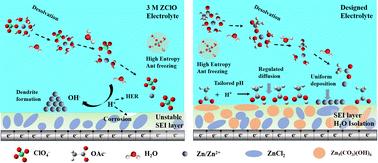当前位置:
X-MOL 学术
›
Energy Environ. Sci.
›
论文详情
Our official English website, www.x-mol.net, welcomes your
feedback! (Note: you will need to create a separate account there.)
Regulating interfacial reactions through electrolyte chemistry enables an anion-rich interphase for wide-temperature zinc metal batteries
Energy & Environmental Science ( IF 32.4 ) Pub Date : 2024-11-19 , DOI: 10.1039/d4ee04803b Yimei Chen, Kaijie Zhang, Zhixiao Xu, Facheng Gong, Renfei Feng, Zhehui Jin, Xiaolei Wang
Energy & Environmental Science ( IF 32.4 ) Pub Date : 2024-11-19 , DOI: 10.1039/d4ee04803b Yimei Chen, Kaijie Zhang, Zhixiao Xu, Facheng Gong, Renfei Feng, Zhehui Jin, Xiaolei Wang

|
Zinc-ion batteries are challenged by zinc dendrites, notorious side reactions, and poor performance at low temperatures. Here, we present a dual-salt tuned electrolyte exhibiting a wide temperature range (−60 to 25 °C). The Zn(ClO4)2-based electrolyte with high hydrogen bond destruction ability and fast diffusion kinetics is suitable for application at ultralow temperatures. The introduction of Zn(OAc)2 salt enhances cation–anion interaction and facilitates the formation of an anion-rich solvation shell and salt-derived interphase, overcoming issues caused by the strong oxidation of ClO4− in the presence of protons. The selective absorption of OAc− on different zinc crystal planes favors dense zinc deposition towards (101) epitaxial while the as-formed anion-rich SEI layer, featuring 2ZnCO3·3Zn(OH)2 distributed on the surface and ZnCl2 uniformly dispersed throughout, inhibits side reactions of corrosion and hydrogen evolution. Consequently, the batteries employing the designed electrolyte exhibited excellent performances, including a high Coulombic efficiency of 99.5% over 800 cycles at 25 °C; a near-unity Coulombic efficiency (100%) for over 4000 cycles and long cycling stability for over 5 months (16 500 cycles) in a Zn//I2 battery with an accumulative capacity of 7300 mA h cm−2 at −40 °C. Even at −60 °C, the solid-state electrolyte demonstrates practical applicability in Zn‖I2/AC and Zn‖VO2 batteries. This dual salt-tuned pure aqueous electrolyte also allows the reversible operation of a pouch cell for over 10 000 cycles with an accumulative capacity of 19.0 A h, indicating its promising potential for constructing safe and environmentally friendly zinc-ion batteries with broad working temperatures.
中文翻译:

通过电解质化学调节界面反应,为宽温锌金属电池提供富含阴离子的界面
锌离子电池受到锌枝晶、臭名昭著的副反应和低温性能不佳的挑战。在这里,我们提出了一种双盐调谐电解质,其温度范围很宽(-60 至 25 °C)。Zn(ClO4)2 基电解质具有高氢键破坏能力和快速扩散动力学,适用于超低温应用。Zn(OAc)2 盐的引入增强了阳离子-阴离子相互作用,并促进了富含阴离子的溶剂化壳层和盐衍生界面的形成,克服了 ClO4− 在质子存在下强氧化引起的问题。OAc− 在不同锌晶面上的选择性吸收有利于锌向 (101) 外延密集沉积,而形成的富含阴离子的 SEI 层,其特点是 2ZnCO3·3Zn(OH)2 分布在表面,ZnCl2 均匀分散在整个范围内,抑制腐蚀和析氢的副反应。因此,采用所设计电解质的电池表现出优异的性能,包括在 25 °C 下 800 次循环中达到 99.5% 的高库仑效率;在 -40 °C 下累积容量为 7300 mA h cm-2 的 Zn//I2 电池中,超过 4000 次循环的近乎统一的库仑效率 (100%) 和超过 5 个月(16 500 次循环)的长循环稳定性。 即使在 −60 °C 的温度下,固态电解质也显示出在 Zn‖I2/AC 和 Zn‖VO2 电池中的实际适用性。 这种双盐调谐的纯水性电解质还允许软包电池可逆运行超过 10000 次循环,累积容量为 19.0 A h,表明它在构建具有广泛工作温度的安全环保型锌离子电池方面具有广阔的潜力。
更新日期:2024-11-19
中文翻译:

通过电解质化学调节界面反应,为宽温锌金属电池提供富含阴离子的界面
锌离子电池受到锌枝晶、臭名昭著的副反应和低温性能不佳的挑战。在这里,我们提出了一种双盐调谐电解质,其温度范围很宽(-60 至 25 °C)。Zn(ClO4)2 基电解质具有高氢键破坏能力和快速扩散动力学,适用于超低温应用。Zn(OAc)2 盐的引入增强了阳离子-阴离子相互作用,并促进了富含阴离子的溶剂化壳层和盐衍生界面的形成,克服了 ClO4− 在质子存在下强氧化引起的问题。OAc− 在不同锌晶面上的选择性吸收有利于锌向 (101) 外延密集沉积,而形成的富含阴离子的 SEI 层,其特点是 2ZnCO3·3Zn(OH)2 分布在表面,ZnCl2 均匀分散在整个范围内,抑制腐蚀和析氢的副反应。因此,采用所设计电解质的电池表现出优异的性能,包括在 25 °C 下 800 次循环中达到 99.5% 的高库仑效率;在 -40 °C 下累积容量为 7300 mA h cm-2 的 Zn//I2 电池中,超过 4000 次循环的近乎统一的库仑效率 (100%) 和超过 5 个月(16 500 次循环)的长循环稳定性。 即使在 −60 °C 的温度下,固态电解质也显示出在 Zn‖I2/AC 和 Zn‖VO2 电池中的实际适用性。 这种双盐调谐的纯水性电解质还允许软包电池可逆运行超过 10000 次循环,累积容量为 19.0 A h,表明它在构建具有广泛工作温度的安全环保型锌离子电池方面具有广阔的潜力。































 京公网安备 11010802027423号
京公网安备 11010802027423号